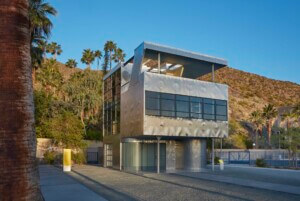Continuing the run of collaborations from Californian prefab home designer and builder Plant Prefab, the company has announced a line of three Passive House-certified “LivingHomes,” all designed in collaboration with the Milford, Pennsylvania-based Richard Pedranti Architect (RPA). The LivingHomes series is Plant Prefab’s range of sustainability-minded, net-zero options, and in the past, the company has teamed up with Yves Béhar, KieranTimberlake, the late Ray Kappe, and modular architecture studio Koto for their designs.
For this newest line, launched January 26, Plant Prefab is squarely targeting the mid-to-upper range homebuyer looking for a ground-up sustainable option. The 2-story, 4-bedroom, 3-bathroom RPA LivingHome 1 spans 2218 square feet and comes topped with a gabled zinc roof, at an estimated price of $586,257—not the final “hard” cost, as Plant Prefab estimates, of $928,407 for a completed house.
Similar to the fully 3D-printed house that recently went up for sale in Riverhead, Long Island, for $300,000, the price is perhaps demonstrative that land prices, permitting, and other currently inflexible costs will keep the touted labor savings of modular or 3D-printed homes from having too much of an impact.
Still, to reach Passive House certification in modular units is an accomplishment: Integrating the high degree of insulation, proper solar orientation requirements, and high-performance windows and doors, as well as maintaining tolerances to keep the enclosure airtight, requires a high degree of communication during the offsite assembly and eventual installation. Plant Prefab credits their ability to do so to their panelized production process, which integrates electrical and plumbing components into swappable panels that can be changed and customized by the client. Overall, Passive House-certified homes are expected to use at least 80 percent less energy on heating and cooling than a comparable building.
As for the other models, RPA LivingHome 2 is quite similar to the first, offering a 2-story, gabled home complete with a garage (somewhat antithetical to the Passive House building it’s attached to) and clocking in at 3 bedrooms, 2.5 bathrooms, with the entire building wrapped with an outdoor porch. The second model starts at $614,428 with a hard cost estimate of about $961,828 for 2316 square feet.
Although RPA LivingHome 3 is only a single story, it also happens to be the most expensive of the trio. Specifically citing mid-century modern design in California and the leisurely, aspirational air of the Case Study houses, the L-shaped Home 3 is centered around a rear patio and pool, with an indoor-outdoor gym owing to rows of operable walls. The last model contains 4 bedrooms, 3.5 bathrooms, and spans a whopping 3182 square feet, but it also starts at $876,949, with an estimated hard cost starting at $1,354,249.
That all three homes are slightly generic in appearance and likely won’t be that much cheaper than a comparable house is beside the point; expanding Passive House standards to the masses, especially with the option to customize finishes and layouts, is a big boon for increasing sustainability in the built environment.










